

It is part of Indonesia of course! You know, the spidery-looking island to the right of Kalimantan . What? Yes, Kalimantan used to be called Borneo and Sulawesi was the Celebes, but none of that reactionary behaviour please.
The trip out was the usual extended grind: hire car to Gatwick while BR was on strike, then Zurich, Abu Dhabi, Jakarta. It was our first stopover at Abu Dhabi and we liked the terminal. It is a strange ornate place that reminded me of a Christmas tree decoration turned inside out: curved, symmetrical, shiny and brightly coloured.
Jakarta was not quite as run-down as we had been expecting, but certainly not run to European standards of repair and cleanliness. We were driven some 18km to a hotel in the suburbs, situated on the bank of a canal near a shopping area. Despite our long journey we were keen to see something of the area so Joan and I walked through the shopping streets. These were "shabby european" and of little interest, but the murky-looking canal seemed to be full of some very strange fish. If you looked into the water for a few minutes you would see a shower of bubbles with a fish in the middle approaching the surface. As the fish reached the surface it did a rapid about turn and dived down again. It was hard to make out detail, but they were up to a foot long with a dark colour and prominent spiky fins. One presumes they were coming up for air.
Whilst we were mostly the only Europeans to be seen, we did not feel isolated or threatened; people seemed more concerned for their own affairs and not eyeing us up as sometimes can happen. Eventually we settled for standing leaning against the side of the main canal bridge and watching the people stream past as the sun was setting. Many handcarts and pedalled carts passed by, with a few taxis and the occasional coach or lorry made its way through the crowds with great difficulty. We enjoyed watching it all until thirst sent us back to the hotel where we ordered a melon drink and an avocado drink. They took ages to arrive, but proved to be the whole fresh fruit pureed to make the drink; really delicious. This prepared us to go and hunt for food, which we opted to do alone since socialising is not best done after long aeroplane journeys. We settled for a Chinese restaurant on the bank of the canal. The big surprise was that in Indonesia a Chinese restaurant is one where all the customers are Chinese! The Indonesian waiter found a menu for us that was written in English and we had some excellent fried noodles before going back to the hotel for an early night.
We were up again at 4am for a breakfast of soup, spicy meat and rice. It was surprisingly good. Then we should then have been driven to the airport. Nothing happened and eventually we discovered that there was indeed a bus waiting but our "minder" had not appeared. We managed to persuade the bus driver that he should take us to the airport and that Explore Worldwide would eventually pay him. We got to the airport and checked-in in time to catch our flight on to Ujung Pandang in Sulawesi.
Here we were met by the tour leader proper: a young man called Simon who had previously been working as a tour leader in Egypt. There were 16 clients on our trip: a lot, but no clashes of personality and an amazing amount of experience with everyone having done several similar tours before. It was only then that we knew that we were the first customers ever for this particular tour. Simon had been met by Mayors and the like when he had been round our proposed route on a recce. Indonesia is keen to build up a tourist industry.
We drove to the Delia Orchid hotel on the airport side of town. It had a strange motel-like nature. The focal point was a large wall-less dining room. The individual rooms were grouped in fours in small two storey buildings. The decor was heavy dark wood and ours had a maroon bathroom suite with a strange wide rectangular bath like a small red sports car. After lunch and a quick bath we went off on a tour of the town. {Not in the bath!}
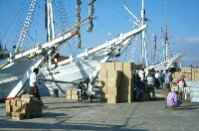 It was a bit dull at first with an old Dutch fort and museum. However we then
went to the harbour where some beautiful Bugis sailing ships were loading and
unloading cargo. We stayed a while, watching as gangs of boys and men carried
heavy loads up gangplanks and into the holds. From there we went on to a silk
weaver's which was shut and everyone had gone home! We drove back to the hotel
for a very pleasant meal, which started with cold pureed Avocado and Banana
drinks before a good meal of noodles, rice and iced beer. It was a quieter day
than we had expected, although pleasant in places.
It was a bit dull at first with an old Dutch fort and museum. However we then
went to the harbour where some beautiful Bugis sailing ships were loading and
unloading cargo. We stayed a while, watching as gangs of boys and men carried
heavy loads up gangplanks and into the holds. From there we went on to a silk
weaver's which was shut and everyone had gone home! We drove back to the hotel
for a very pleasant meal, which started with cold pureed Avocado and Banana
drinks before a good meal of noodles, rice and iced beer. It was a quieter day
than we had expected, although pleasant in places.
The next day was a 6:30 start for breakfast, then the airport and a plane to Palu in the north of the island. (The Nelles Indonesia 6 map is useful: if you wish, you could have a look at the Palu section in a second browser window ) As the plane climbed out over the sea we could see hundreds of little sandy islands all around the main island; some were tiny and actually under water, others had huts on them. As we flew north and came inland again the scenery turned to mountains covered in trees. There were occasional huts in clearings and no roads visible. This was the country we had come here to traverse. The final descent to Palu was along a valley with small fields and just one road. The Palu Golden Hotel was amazingly modern and well equipped and had a swimming pool as well as being on the beach.
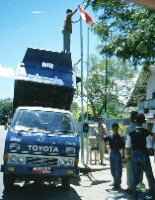 We met our three local guides. The chief guide was called Excellent or Excel
and the others were Pahrul and Augustus. A surfeit of guides indeed, but the
local travel agency wanted them all to go on the trip and find out about this
new opportunity. Then followed a mundane round of banks, ebony-carvers and the
like. This was enlivened by watching the town being decorated for the 25th
Independence celebrations without using a ladder but making ingenious use of a
tipper lorry. While we were watching this acrobatic feat, we had some locals
chatting to us including one chubby little man who mentioned that his name was
Ben Hur. In the evening we were persuaded to attend a formal celebration dinner
with the local dignitaries present while speeches, singing and dancing were
laid on. The food was interesting and served buffet style, while the costume
dancing was pleasant.
We met our three local guides. The chief guide was called Excellent or Excel
and the others were Pahrul and Augustus. A surfeit of guides indeed, but the
local travel agency wanted them all to go on the trip and find out about this
new opportunity. Then followed a mundane round of banks, ebony-carvers and the
like. This was enlivened by watching the town being decorated for the 25th
Independence celebrations without using a ladder but making ingenious use of a
tipper lorry. While we were watching this acrobatic feat, we had some locals
chatting to us including one chubby little man who mentioned that his name was
Ben Hur. In the evening we were persuaded to attend a formal celebration dinner
with the local dignitaries present while speeches, singing and dancing were
laid on. The food was interesting and served buffet style, while the costume
dancing was pleasant.
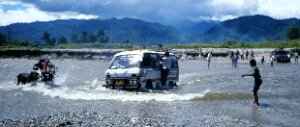
Today's start began at 8:00 for 9:30 start in a column of 4wd vehicles. The country seemed very peaceful and near the road it was dominated by rice paddies. We liked the groups of children making their way home from their "two-shift" schools. They were immaculate in their uniforms and we particularly liked the ones who were carefully carrying their shoes as they walked along the stony roads. These roads seemed fairly good at first, but as we approached our destination there was a fairly substantial river to ford. Ours, as the oldest and presumably the most expendable vehicle, was used as a trial. The fact I am writing this shows it succeeded and the other vehicles followed.
Our destination was a hutted camp in a forest clearing of the Lore Lindau Park.
These were comfortable huts set a little way above the ground on poles. The
lunch of rice, vegetables and fruit was excellent. Shortly afterwards the rain
fell in stair-rods for a while. It was nice to be under cover and watching it.
The rain stopped as suddenly as it had started and Joan and I went for a walk
on our own. It was along a jeep trail with several detours off on woodcutters
tracks into the rain forest; very enjoyable.
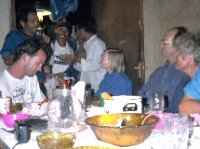 The evening was pleasant for Joan with chatting round a meal. For me it was bed
with a splitting headache. In the afternoon our vehicles had been moved back to
the far side of the river as a precaution because of possible rains upstream.
The evening was pleasant for Joan with chatting round a meal. For me it was bed
with a splitting headache. In the afternoon our vehicles had been moved back to
the far side of the river as a precaution because of possible rains upstream.
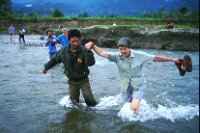 Up today at 6:30 for a good breakfast and a walk to the river where we had to
wade across. This seemed tolerably adventurous in prospect, but passed off
smoothly. Today there was a long drive broken by a 7km walk which could have
been very good, but was unimaginatively arranged on the basis of "get out of
the vehicles at Dongi Dongi and walk along the jeep road until you catch them
up again at Marora". It was pleasant but would have been so much better if say
we had done it on a footpath cutting across a bend or following parallel to the
road route. We drove on to lunch at Wuasa. This was definitely an experience.
We stopped at a scruffy little house in quite a large village and there we were
treated to a lunch consisting of piles of boiled rice and big dishes of boiled
fish-heads; not nice. We continued on rougher roads and one of our vehicles, a
4wd bus, had to be towed to get it through the worst potholes.
Up today at 6:30 for a good breakfast and a walk to the river where we had to
wade across. This seemed tolerably adventurous in prospect, but passed off
smoothly. Today there was a long drive broken by a 7km walk which could have
been very good, but was unimaginatively arranged on the basis of "get out of
the vehicles at Dongi Dongi and walk along the jeep road until you catch them
up again at Marora". It was pleasant but would have been so much better if say
we had done it on a footpath cutting across a bend or following parallel to the
road route. We drove on to lunch at Wuasa. This was definitely an experience.
We stopped at a scruffy little house in quite a large village and there we were
treated to a lunch consisting of piles of boiled rice and big dishes of boiled
fish-heads; not nice. We continued on rougher roads and one of our vehicles, a
4wd bus, had to be towed to get it through the worst potholes.
We arrived early in Watutau where we were billeted in private houses. These were surprisingly ordinary, each consisting of a fair sized bungalow in a big fenced garden. They were all set out on a wide and clearly defined road which lacked either a surface or any vehicles. We were soon to realise this was the norm in Sulawesi and presumably reflects a tidiness of the former Dutch colonial powers.
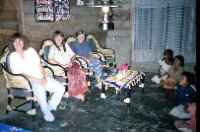 Joan and I had a four-poster bed for the night. The family were very friendly
and we spent some time sitting in the main room with them. The floor was
covered in a long row of children from the neighbourhood watching us. We tried
to learn some of eachother's language. The principal Indonesian language is
very simple: for example enak is a child while two or more children are enak
enak. Later we went for a short walk and met up with our group for dinner
together.
Joan and I had a four-poster bed for the night. The family were very friendly
and we spent some time sitting in the main room with them. The floor was
covered in a long row of children from the neighbourhood watching us. We tried
to learn some of eachother's language. The principal Indonesian language is
very simple: for example enak is a child while two or more children are enak
enak. Later we went for a short walk and met up with our group for dinner
together.
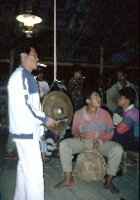 In the evening the villagers wanted us to attend a dance. It was in a big
covered platform with a wooden floor. Everyone took part in the dance which
consisted of doing a slow shuffle in a big circle, to the beating of a gong.
In the evening the villagers wanted us to attend a dance. It was in a big
covered platform with a wooden floor. Everyone took part in the dance which
consisted of doing a slow shuffle in a big circle, to the beating of a gong.
We had a quiet morning in Watutau after a most memorable breakfast. It consisted of a cold fried egg perched on top of a slice of cake. Apparently the cooks had been told we did not really go for boiled rice for each meal even if it did have a few chillis in it. They had tried to find something more exotic and, due to the modest stock of the local shop, had ended with something we all felt was truly exotic.
Today we had a free morning which Joan and I spent walking in the heat along a jeep track up a hill overlooking the village and its surrounding countryside. At lunch several people remarked about the strange Indonesian dogs. They are smallish, yellow and have curving tails, but the odd feature is the way they lie relaxed in roads and paths. They never bark and you can actually step over one without it showing any reaction.
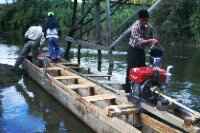 After lunch we set off at 2pm in a pair of dugout canoes that had recently been
nailed together; then a "long-tail" engine and propeller had been added. There
were a number of minor rapids and shallows to be negotiated and the crew were
definitely learning the ropes. At times it would have been nice to take
control! The weather was warm, which was good since we had to get out and push
quite a few times.
After lunch we set off at 2pm in a pair of dugout canoes that had recently been
nailed together; then a "long-tail" engine and propeller had been added. There
were a number of minor rapids and shallows to be negotiated and the crew were
definitely learning the ropes. At times it would have been nice to take
control! The weather was warm, which was good since we had to get out and push
quite a few times.
When we finally arrived, we started a walk to Torire and had to cross a substantial river by a brand new bridge. Nearby was the old one: a shabby suspension bridge constructed of lianas which had been in use until the new one was finished. I fancied crossing it and went with Pahrul, our young Indonesian guide, to do so. Unfortunately it was badly damaged and although the four lianas were intact, the floor was missing and many cross-links were broken. It was clearly not possible and we turned away. Then Pahrul suddenly rushed back and started to cross it on two of the lianas. He succeeded, although it looked pretty tricky. Feeling that this was a case where one had to fly the flag, I followed. It was difficult: it was very unstable and at times I had to hang in very tiring positions to stop the structure inverting. I was quite glad to reach the far side and puffing a bit! Later it was pointed out that I was twice his weight and had a rucksack on; ergo I am stupid.
In Torire we were again billeted in village houses. We inquired about the mandi {bath} and were told to go to the river. I think we confused the instructions since, after asking several people along the way, it must have been half a mile from where we were staying. The place we actually found was a most delightful little stream running in a curve over a rocky bed and sheltered by trees and bushes.
Dinner was at a central building and was, I think, quite good. However I was distracted by a strange event. Just after dinner, while we were sitting drinking and talking, I had a sudden violent pain low in the abdomen. I got up and set off to look for the loo and felt rather faint. I was led through some dark room with uneven floors when I felt my limbs relax and I fell forward, blacking out as I went. As far as I can tell, I hit the floor but never went fully flat. Instead I came up to my feet again feeling fine and with the pain gone. I realised that several locals were looking at me aghast from the shadows, but I continued to the loo and then returned to the table. Apart from a bruised wrist there were no ill effects. I wish I understood what happened.
(See next year's trip for the finger of suspicion to fall on Lariam - an anti-malarial drug)
We left at 9:00 on foot and had an enjoyable walk of 17km, on jeep tracks although the only vehicle we saw was one lorry. Throughout the day we were accompanied by a local lady in sandals, carrying an umbrella as a sunshade and with a live chicken tucked under her arm. I do not know what she made of our rucksacks and big boots. It was overcast and tolerably cool so it was good walking. For one section there was attractive thick jungle on either side and Joan saw a monkey although I was not with her and missed it.
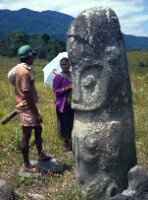 The area we were heading for is famous for its megaliths. However there were
certainly no kiosks and ice cream stalls advertising the place! We asked
directions of locals to the Tadulako stones and followed faint paths which
petered out in clumps of bushes and then, suddenly, we were standing beside a 3
metre high stone statue, a few hundred years in age. All around were rough
grassy fields extending along the valley bottom and not a soul in sight.
The area we were heading for is famous for its megaliths. However there were
certainly no kiosks and ice cream stalls advertising the place! We asked
directions of locals to the Tadulako stones and followed faint paths which
petered out in clumps of bushes and then, suddenly, we were standing beside a 3
metre high stone statue, a few hundred years in age. All around were rough
grassy fields extending along the valley bottom and not a soul in sight.
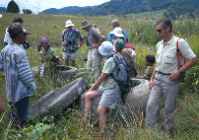 We had a good look and moved on to see some vast cylindrical containers with
lids, also carved in stone. It all felt like it was happening on a different
planet.
We had a good look and moved on to see some vast cylindrical containers with
lids, also carved in stone. It all felt like it was happening on a different
planet.
We continued our walk, making rather heavy weather of crossing some rice fields as we neared Doda. At one point Tom fell off the raised dyke, on which we were walking, and vanished into a rice paddy. He made rather a spectacular job of it, getting soaked and also dropping a camera into the water! When we finally got to the village, we found we were to stay in a set of houses in a large compound. Joan and I remember it for a bed of Herculean proportions on which we camped near one end; also for the smoky atmosphere of the open cooking fires at the other end of the building. We had the afternoon free and went down to the river for a bath and to do some washing. Later Joan and I went for a walk around the village which had some well kept gardens. In the fields round about, there were many villagers camped out in the paddy fields to shoo birds off the ripening rice crop.
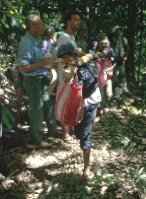 Today we were up quite early and set off on foot with a team of porters. They
were not used to the work and several insisted on carrying our bags slung
either end of a thick bamboo on their shoulders. The route lay mostly on jeep
tracks in mountainous conditions. As the day progressed we moved into the
forest-covered mountains and the path became a little thing the width of a
human foot or thereabouts, on steep hillsides. Often fallen trees blocked the
path, but the locals have a neat way of cutting a notch on the outer part of
the trunk so you can sort of swing round it and continue. This was easily the
best walking of the whole trip and I was almost sorry to stop when we came to a
carefully-prepared set of lean-to shelters beside some waterfalls and pools in
the depths of the forest.
Today we were up quite early and set off on foot with a team of porters. They
were not used to the work and several insisted on carrying our bags slung
either end of a thick bamboo on their shoulders. The route lay mostly on jeep
tracks in mountainous conditions. As the day progressed we moved into the
forest-covered mountains and the path became a little thing the width of a
human foot or thereabouts, on steep hillsides. Often fallen trees blocked the
path, but the locals have a neat way of cutting a notch on the outer part of
the trunk so you can sort of swing round it and continue. This was easily the
best walking of the whole trip and I was almost sorry to stop when we came to a
carefully-prepared set of lean-to shelters beside some waterfalls and pools in
the depths of the forest.
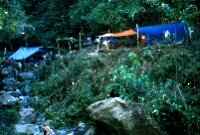 The situation was idyllic. Our camp was right in the depths of the rainforest
with only the one minuscule path in and another out. Clean fresh water gushed
past the lean-to's and made a bathing pool some 30m below the camp. The cooking
fires were on the opposite bank and the waiter-service arrived via some
stepping stones. After lunch, Joan and I walked further along the trail then
spent some hours just lying in the sunshine, looking up into the forest canopy
and being practically deafened by the noise of cicadas.
The situation was idyllic. Our camp was right in the depths of the rainforest
with only the one minuscule path in and another out. Clean fresh water gushed
past the lean-to's and made a bathing pool some 30m below the camp. The cooking
fires were on the opposite bank and the waiter-service arrived via some
stepping stones. After lunch, Joan and I walked further along the trail then
spent some hours just lying in the sunshine, looking up into the forest canopy
and being practically deafened by the noise of cicadas.
In the evening we sat in the open having dinner and then sitting with a drink. I went down to the river and was puzzled by the large number of cans of beer keeping cool in the water, when we had only one more night away from supplies. Simon insisted again that we had stocked-up for the correct number {of 6 nights}. Several people said they could not make it more than 5 nights so Simon began counting them for us: "Kama Rora, Watutau, Torire, Doda and Taba" ... the first four on the fingers of one hand and the last on a finger of the other hand. Then a triumphant "There you are ... six!". There was a short silence and then we all shouted at him "Simon, you are supposed to use your thumb as well!".
Up early and pleasant walking; 22km today. The paths were similar to yesterday's and produced something novel. In all the years I have walked I had never before experienced anyone falling off a mountain path. Today there were several including one of the porters, who actually fell some way and hurt himself. I was yards from another incident, when David vanished over the edge to fall some 5m into bushes. I helped him find his camera which sadly was u/s after its fall. David, luckily, was OK. I am at loss to know why falling was so much in vogue. The paths were what most walkers like: varied, picturesque and absorbing of concentration.
At lunch we stopped at a place called Mongimbo. Although it had a name it was literally just a place in the wilderness, but a nice place. It was at the side of a largish river and we could have a swim in the cool water before our lunch. There were some quiet back-eddies in which to swim; the main current was too fast to swim against, but not fast enough to be dangerous.
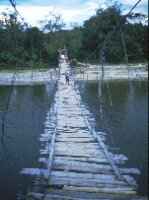 It was well into the afternoon before we began to cross the outlying paddy
fields of the villages. Finally we came to a long suspension bridge across the
river. By long I mean 70m or so against the 20m of "my" earlier bridge. The
bridge was substantial but made from materials that looked like Steptoe and
Son's throwouts. Our party went across one at a time. The locals were puzzled
by our antics and one lady marched smartly across carrying a child on her hip.
It was well into the afternoon before we began to cross the outlying paddy
fields of the villages. Finally we came to a long suspension bridge across the
river. By long I mean 70m or so against the 20m of "my" earlier bridge. The
bridge was substantial but made from materials that looked like Steptoe and
Son's throwouts. Our party went across one at a time. The locals were puzzled
by our antics and one lady marched smartly across carrying a child on her hip.
Once across the river we marched a couple of km and came to what we took to be our destination, particularly when we turned off into a garden with lots of chairs set out and fruit and drink waiting on a table. We thankfully guzzled tea, coffee, coconut milk, pomelo and bananas. (You might think I meant a selection from that list, but you would be wrong.) However this was not our destination, but just a refuelling stop. The final walk was not long and felt easy to the refreshed voyagers. At Bomba our stopover was in a small losmen in the middle of the village, with a small shop next door with a monkey in the garden. Rooms were small and ours was effectively two double beds separated by a curtain with a shared half-metre wide strip of floor at their foot. Joan and I had one bed and Chris and Mary had the other.
Joan had a look at Charlie, who had also fallen off the path and was feeling very sore, and she diagnosed a broken rib. Luckily only one was broken and strapping it with lots of plaster helped minimise the movement and pain. The previous night Gavin, Simon and myself had finished off the last of the real whisky. Now Gavin bought a bottle of local whisky from the shop. It was a strange caramel flavoured concoction, nearer to rum than whisky. Still it was very nearly acceptable after a day out walking.
Up at 6am as dawn broke. Out walking through a mixture of scrub, grass and paddy. Only 12km to cover. We saw one deer in the early part of the day. Our main stop was at the megaliths of Palindu and Maturu. This had been prettied-up a bit by having paved paths to join the attractions. I gather that tourists go there by 4wd or by plane, but we did not see any. Megaliths are not my favourite fare; I enjoyed more seeing a copy of a large community house that had been built nearby. We wandered through it looking at the lofty all-wooden construction and the suspended earth fireplaces.
It was getting pretty hot and we were glad to stop at an open-sided shelter where some locals had brought coconuts and pomeloes for us. The coconut milk was OK for thirsty people, but the pomeloes were better. They were nearly the size of a rugby ball and I must confess to eating all of mine; I needed the juice.
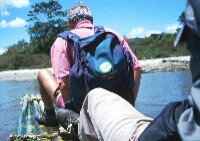 Next we needed to cross the river. It would have been possible to wade it, but
we were ferried across three at a time on a raft of bamboo. The middle of the
raft was totally below water and the ends were just above. It was interesting.
By now it was really hot and we were very glad to arrive at what we thought was
our destination village. Unhappily it was not so and the true destination was a
larger village several km further. We just wanted to get finished at that stage
and the final walk was done vigorously. At our destination, a large losmen in
Gintu, they had wickerwork loungers outside under the trees. Not only did they
have beer but they served it iced as well. It was magic. We could have gone on
another walk in the afternoon, but it was very hot and all I did was doze on
the bed before a good wash in the mandi and more iced beer ready for an
excellent dinner.
Next we needed to cross the river. It would have been possible to wade it, but
we were ferried across three at a time on a raft of bamboo. The middle of the
raft was totally below water and the ends were just above. It was interesting.
By now it was really hot and we were very glad to arrive at what we thought was
our destination village. Unhappily it was not so and the true destination was a
larger village several km further. We just wanted to get finished at that stage
and the final walk was done vigorously. At our destination, a large losmen in
Gintu, they had wickerwork loungers outside under the trees. Not only did they
have beer but they served it iced as well. It was magic. We could have gone on
another walk in the afternoon, but it was very hot and all I did was doze on
the bed before a good wash in the mandi and more iced beer ready for an
excellent dinner.
 This is a good place to mention the mandis: an Indonesian device. A mandi is a
small room with a huge tank of water and a scoop. You soap yourself and then
throw scoops of water over yourself to remove the soap; or just for the general
fun of being wet and cool. It is actually better than a shower in hot
conditions and it can be set up anywhere on virtually no money.
This is a good place to mention the mandis: an Indonesian device. A mandi is a
small room with a huge tank of water and a scoop. You soap yourself and then
throw scoops of water over yourself to remove the soap; or just for the general
fun of being wet and cool. It is actually better than a shower in hot
conditions and it can be set up anywhere on virtually no money.
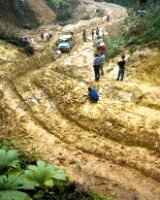 We should have had a 7:00 start, but we were missing one jeep. It was finally
found and we got going. The jeeps sounded like stock car racers and looked
rather like them too. The road was rough and climbed steeply into the
mountains. At first the road was appalling, but it soon got worse than that! We
were tossed about and splattered by mud thrown from the spinning wheels. Each
few minutes the previous worst bit was exceeded by something new.
We should have had a 7:00 start, but we were missing one jeep. It was finally
found and we got going. The jeeps sounded like stock car racers and looked
rather like them too. The road was rough and climbed steeply into the
mountains. At first the road was appalling, but it soon got worse than that! We
were tossed about and splattered by mud thrown from the spinning wheels. Each
few minutes the previous worst bit was exceeded by something new.
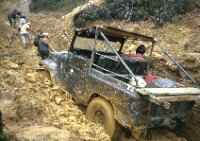 The true highlight of the obstacle course was one single short ascent of a
clay-based road in a damp and rainy area in the mountains. Previous vehicles
which had got bogged down there had been kept going by digging down to
less-disturbed clay. The result was a groove the width of a jeep and deep
enough to come almost to window level. This was ascended by digging out the
slimiest clay and by pulling on towing ropes as the vehicles were gunned to
full throttle. It took well over an hour to get all the vehicles up.
The true highlight of the obstacle course was one single short ascent of a
clay-based road in a damp and rainy area in the mountains. Previous vehicles
which had got bogged down there had been kept going by digging down to
less-disturbed clay. The result was a groove the width of a jeep and deep
enough to come almost to window level. This was ascended by digging out the
slimiest clay and by pulling on towing ropes as the vehicles were gunned to
full throttle. It took well over an hour to get all the vehicles up.
That hill was not the end of the difficulties and the travel remained interesting. We took 7hrs to cover 42km. The total, including the easier sections, was only 72km for the day.
The losmen "Victory" at Tentena was pleasant. The rooms opened on to a small garden and they were light and airy with a welcoming mandi at the back; after our journey we were covered in mud from spinning wheels. Although there was food available at the losmen we went for a short walk to a lake edge restaurant with Gavin, Becky and Sylvia for a good meal and lots of very cold beer.
Breakfast was a dish of fresh fruit eaten at a table outside the door of our room, overlooking the garden. There was some problem in obtaining the promised boat on time and we spent the morning on a minibus drive to some waterfalls. We returned to the hotel with some free time, but Joan was not feeling well.
 While Joan rested, I went with Becky to get some photos. There was an
interesting local market and the whole area was full of cloves laid drying on
all the pavements and gardens. At one point I asked Becky why she was taking a
picture of a house with a display of scruffy-looking bottles full of a pale
yellow liquid. When she replied that she was just photographing a typical
Indonesian petrol station, I took a photo as well.
While Joan rested, I went with Becky to get some photos. There was an
interesting local market and the whole area was full of cloves laid drying on
all the pavements and gardens. At one point I asked Becky why she was taking a
picture of a house with a display of scruffy-looking bottles full of a pale
yellow liquid. When she replied that she was just photographing a typical
Indonesian petrol station, I took a photo as well.
There is an interesting long bridge across the river at Tentena; very narrow and with a police-controlled tidal flow of traffic across it and with good views of nearby eel-traps. The narrowness of the bridge became apparent when Becky had the sleeve of her blouse torn by the brake lever of a passing motor-cycle.
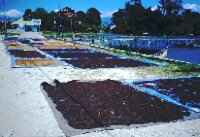 Back at the hotel, Joan had staged a rapid recovery and we all set off across
the lake in a medium-sized boat with a packed lunch provided. It was a relaxing
journey and we were heading for a remote orchid garden. The garden was
beautiful to walk through, being situated on a steep rocky promontory covered
in trees. However the orchids were not performing at the time we went there. We
had an enjoyable walk along the hillside paths and spent some time in the woods
just sitting and enjoying our surroundings. Afterwards we had a swim in the
lake. This was in clear, warm unrippled water and was most enjoyable. By then
it was getting late, but we did not have far to go in our boat to the remote
fishing village where we were to spend the night.
Back at the hotel, Joan had staged a rapid recovery and we all set off across
the lake in a medium-sized boat with a packed lunch provided. It was a relaxing
journey and we were heading for a remote orchid garden. The garden was
beautiful to walk through, being situated on a steep rocky promontory covered
in trees. However the orchids were not performing at the time we went there. We
had an enjoyable walk along the hillside paths and spent some time in the woods
just sitting and enjoying our surroundings. Afterwards we had a swim in the
lake. This was in clear, warm unrippled water and was most enjoyable. By then
it was getting late, but we did not have far to go in our boat to the remote
fishing village where we were to spend the night.
On our arrival we attracted a turn-out of practically the whole village; tourists are a big novelty. We were ferried ashore in dugout canoes. We stayed at the headman's house where the whole group were to assemble for dinner. After the dinner we attended another dance, but this time mainly a display of costume dancing, which was very good.
Up late at 7:15 for breakfast which, surprisingly, consisted of bread rolls. That must have been the nearest to European food on the whole trip. A pleasant 90min voyage across the lake took us to Pendolo for a landing on the ricketiest of jetties made from thin wood. We hung around drinking coffee until our bus turned up and we set off along a tarmaced road! After three hours we arrived at another motel-style place with good rooms and good food. There was just one very long street. Walking up and down the street gave one the impression that this was a world centre for the sale of bicycles and chairs, but not a lot else. As the day drew to a close, our hotel yard filled with lorries: this was obviously a popular place for lorry drivers. The evening was memorable for a good and plentiful meal. I guess this is what attracted the lorry drivers.
Tomorrow we head into the South part of the island, still on the Nelles Indonesia 6 map. If you wish, you can open that part in another browser window )
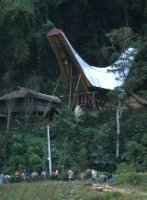 A good breakfast at 7:00 then off again. We were in the bus on a winding road
until 13:30 on fairly good roads. Towards the end of the drive we were
beginning to see our first tongkonan. The area around Rantanpao is a tourist
zone: the spectacular tongkonan and cliff graves are the main attractions. A
tongkonan is a house or barn with a giant roof in the form of buffalo horns, or
if you prefer, the shape of a water melon slice.
A good breakfast at 7:00 then off again. We were in the bus on a winding road
until 13:30 on fairly good roads. Towards the end of the drive we were
beginning to see our first tongkonan. The area around Rantanpao is a tourist
zone: the spectacular tongkonan and cliff graves are the main attractions. A
tongkonan is a house or barn with a giant roof in the form of buffalo horns, or
if you prefer, the shape of a water melon slice.
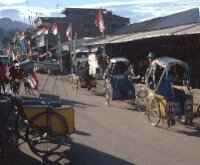 Rantanpao is a large town, with many hotels. Ours was the Torsina on the
outskirts of town and situated in the middle of rice paddies. It had pleasant
rooms and a swimming pool. After lunch we went into town to have a look around
the shops and market. We found a rather European style small restaurant called
Poppies that did a range of local foods and we booked a meal there for the
evening. Joan and I returned to the hotel in a couple of becaks {three-wheeler
cycle taxis}.
Rantanpao is a large town, with many hotels. Ours was the Torsina on the
outskirts of town and situated in the middle of rice paddies. It had pleasant
rooms and a swimming pool. After lunch we went into town to have a look around
the shops and market. We found a rather European style small restaurant called
Poppies that did a range of local foods and we booked a meal there for the
evening. Joan and I returned to the hotel in a couple of becaks {three-wheeler
cycle taxis}.
In the evening we had a very enjoyable dinner in the company of Chris and Mary. After the dinner it was late and we failed to find any becaks. We walked home in the dark warm night.
The day started badly when I realised that I had been badly bitten during the night by the wildlife in my bed. So much for the fancy decor and swimming pool! Luckily Joan had escaped them in her bed.
We had a new guide; a rather seedy looking man in a leather jacket who spoke only mumbled English. Today we were to be taken by bus to the start of a walk. This started along boring roughly-paved jeep tracks, which did not please us. Further tramping through a large coffee plantation with only coffee bushes to look at was not too good either. The whole thing became impossible when, after a full hour of dull walking in the rain, we ended up back at our starting point. We had to get a local man to show us the correct route.
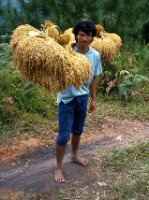 After a while things began to improve as we left the plantation roads and got
on to better paths and better scenery. We were now among hills with terraced
paddies and patches of woodland. There were many fine tongkonan along the way
and we found an elderly couple winnowing rice on a hilltop and apparently
carrying out some sort of ceremony associated with it. Our final destination
was a village called Londa with an impressive set of tongkonan decorated with
masses of fine carving. There was also a great gang of fruit bats hanging from
trees nearby.
After a while things began to improve as we left the plantation roads and got
on to better paths and better scenery. We were now among hills with terraced
paddies and patches of woodland. There were many fine tongkonan along the way
and we found an elderly couple winnowing rice on a hilltop and apparently
carrying out some sort of ceremony associated with it. Our final destination
was a village called Londa with an impressive set of tongkonan decorated with
masses of fine carving. There was also a great gang of fruit bats hanging from
trees nearby.
From there it was only a short distance to a tongkonan on a small hilltop where we were to spend the night. The accommodation was comfortable if a little cramped and the surroundings enjoyable. The bad news was dinner: a horrible dish of boiled fish heads and plain rice. Nearly all our party we just ate boiled rice and a few bananas. Afterwards Joan, Becky and myself sat for a while under a rice-barn tongkonan and just enjoyed the atmosphere of the night before finally turning in.
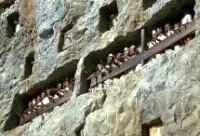 Up early for a disgusting breakfast at 6:30. We drove to Lemo and were given a
guided tour of the cliff wall graves. These have rows of "tautau" statues
depicting the deceased in rows along cliff galleries. There was also a group of
tourist shops nearby. The atmosphere was a rather commercial one. We travelled
on to another site, which was better and less infested with guides and
souvenirs.
Up early for a disgusting breakfast at 6:30. We drove to Lemo and were given a
guided tour of the cliff wall graves. These have rows of "tautau" statues
depicting the deceased in rows along cliff galleries. There was also a group of
tourist shops nearby. The atmosphere was a rather commercial one. We travelled
on to another site, which was better and less infested with guides and
souvenirs.
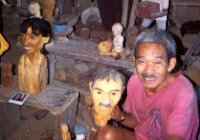 Across from the site on the other side of some rice paddies was a simple house
where we met an elderly tautau carver. He was no longer interested in money and
obviously enjoyed being the centre of attention. When we visited him, he was in
the middle of carving a tautau of an American woman using a photo of her. He
also had two tautau of himself. Many tautau were lined around the workshop and
a hen and her chickens scratched around on the floor. The carver had a
dog-eared copy of the magazine of Garuda, the Indonesian national airline, with
an article about himself in it.
Across from the site on the other side of some rice paddies was a simple house
where we met an elderly tautau carver. He was no longer interested in money and
obviously enjoyed being the centre of attention. When we visited him, he was in
the middle of carving a tautau of an American woman using a photo of her. He
also had two tautau of himself. Many tautau were lined around the workshop and
a hen and her chickens scratched around on the floor. The carver had a
dog-eared copy of the magazine of Garuda, the Indonesian national airline, with
an article about himself in it.
We drove on and finally left our bus for a walk on a jeep road going uphill to Batu Tumonga. It was a pity to be walking on roads yet again, although this one had pleasant scenery and villages. At one point we came across two workmen who were hollowing out a boulder as a tomb. They had been working for six weeks and were well on the way to completion. These tombs are an alternative to cliff graves. They are hard work, being hollowed out in vast glacial boulders composed of what looked like granite.
We arrived at the losmen Mantirotika where we ate a good lunch in an open-sided restaurant with a spectacular view over the surrounding countryside. We put our belongings in a well-kept tongkonan, where we were to spend the night. Our luck in accommodation seemed to be changing.
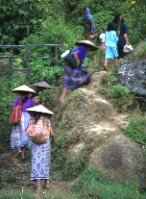 Joan and I walked up the hill road a good way and visited two villages, as did
most of our party, who were enjoying walking in small groups instead of our
usual crocodile. We passed what appeared to be a procession of water buffalo
heading for their fate in a local funeral ceremony. A little further we found a
completed but unoccupied hollow boulder. I was inside it taking photos when the
procession passed and one man made some remark about me that amused his
companions. Probably something like "Trying it for size then?".
Joan and I walked up the hill road a good way and visited two villages, as did
most of our party, who were enjoying walking in small groups instead of our
usual crocodile. We passed what appeared to be a procession of water buffalo
heading for their fate in a local funeral ceremony. A little further we found a
completed but unoccupied hollow boulder. I was inside it taking photos when the
procession passed and one man made some remark about me that amused his
companions. Probably something like "Trying it for size then?".
We continued above the upper village and met some very rural-looking locals who were dressed in their best and carrying large lumps of cooked meat. I should explain that the local custom is to save-up for a very elaborate funeral with vast numbers of guests and the slaughter of numbers of expensive water buffalo in a ceremony that goes on for several days. There is a tax on funerals and we suspect that the people we saw were just returning from an undeclared {tax fiddle} funeral.
We got back to the losmen at 17:30 in the twilight and settled down to a good meal and a comfortable nights sleep.
Today we were walking down off the mountain to our bus. It was a much better walk than the uphill one: we went down a footpath rather than a road. The path went through a number of small villages and past some very attractive buildings. We particularly liked a small smithy that we passed. Just an open-sided hut perhaps 4m by 4m in floor size, with a tiny bellows-operated furnace in one corner, where they were fashioning machetes and heat treating them ready for market.
Soon we were back to the hotel Torsina in Rantanpao. I was totally resistant when they wanted to give Joan and me the room we had had before. However they eventually explained by sign language that the mattress had been replaced by another one. A member of our group had actually seen the replacement mattress brought in, so I agreed to the room and it later proved to be bug-free.
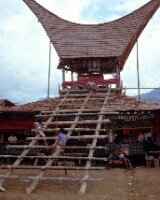 In the afternoon we were looking for a funeral, which is a major event in these
parts. We set off in our bus into the local countryside, getting lost once or
twice. Eventually we found the place and, on open fields behind the village, a
square of two-storey grandstands about 100m square had been built and
decorated. In the square were tethered perhaps eight or nine water buffaloes
and the bloody remains of some others lying the ground. The key animal was a
large near-white animal {the lighter the colour the greater the status and the
higher the price}. A higher building held the remains of the principal person:
a lady who had been dead for two years while her folks worked on preparing the
funeral celebrations.
In the afternoon we were looking for a funeral, which is a major event in these
parts. We set off in our bus into the local countryside, getting lost once or
twice. Eventually we found the place and, on open fields behind the village, a
square of two-storey grandstands about 100m square had been built and
decorated. In the square were tethered perhaps eight or nine water buffaloes
and the bloody remains of some others lying the ground. The key animal was a
large near-white animal {the lighter the colour the greater the status and the
higher the price}. A higher building held the remains of the principal person:
a lady who had been dead for two years while her folks worked on preparing the
funeral celebrations.
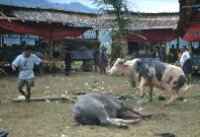 While we were there the white buffalo was sacrificed. It was tethered to the
carcass of one of its dead fellows and the owner, who had been lavishing care
on the poor animal all its life, slashed its throat with a machete. As if that
were not bad enough, he made a hash of it and needed some four or five further
cuts before the rampaging beast finally fell to its knees and
expired
. We came away feeling a little out of sympathy with this particular set of
customs.
While we were there the white buffalo was sacrificed. It was tethered to the
carcass of one of its dead fellows and the owner, who had been lavishing care
on the poor animal all its life, slashed its throat with a machete. As if that
were not bad enough, he made a hash of it and needed some four or five further
cuts before the rampaging beast finally fell to its knees and
expired
. We came away feeling a little out of sympathy with this particular set of
customs.
After returning to the hotel we went in to town and had a lunch of very good giant sandwiches at Poppies. This time we were eating in the company of a large part of our group: good news travels quickly. We did some souvenir shopping and then returned to the hotel for a quiet evening over dinner.
Off at 8:30 after a good breakfast of pancakes and a special rice sweet dish. The day was spent driving through tree-clad mountains on a winding road, but it was too long to be enjoyable. By the end we had covered 220km. The best part was a lunch stop in a large private flat belonging to the tour operator. The lunch was excellent and it was interesting to see the inside of a home of its type.
In Senkang, the Hotel Apada was very good. It had attractive rooms arranged off of rambling staircases and galleries around an irregular central courtyard with some plants and trees. The food was also excellent, although sadly we were full of food and unexercised.
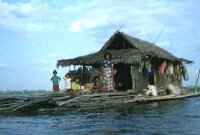 In the afternoon we went on a trip down the river in a series of dugouts driven
by "long-tail" motors. The river soon opened into a series of lagoons separated
by marshes; all part of an inland lake. There was a lot of birdlife and it was
easy to get relatively close to the birds. There were also many fishermen in
boats similar to our own and there were many houseboats belonging to fishermen.
These houseboats were moored in the middle of water and accessible only by
boat. At the furthest point of our trip we visited one such boat whose owner
sold tea to people such as ourselves.
In the afternoon we went on a trip down the river in a series of dugouts driven
by "long-tail" motors. The river soon opened into a series of lagoons separated
by marshes; all part of an inland lake. There was a lot of birdlife and it was
easy to get relatively close to the birds. There were also many fishermen in
boats similar to our own and there were many houseboats belonging to fishermen.
These houseboats were moored in the middle of water and accessible only by
boat. At the furthest point of our trip we visited one such boat whose owner
sold tea to people such as ourselves.
The return trip gave us some fine views embellished by a setting sun. Our arrival back in town included a tramp ashore across river mud, picking our way between locals washing in the river. Then a walk through the back street to regain our hotel.
In the evening we opted to have a Bugis upper-class meal. This was served to us as we sat on the floor and each person had a young Bugis girl sitting alongside to fill their plates and cups. After dinner the same girls put on a display of costume dancing.
We had a moderately early start and then yet another dull drive of 306km with the early part on poorly-surfaced roads. We stopped at a place called Sinjai, which was rather nondescript. There we tried to get coffee in a small scruffy cafe but nearly ended up with a full lunch, due to our inability to speak the language. Further along the journey we passed through an area of rubber plantations; it was the first time I had ever seen commercial rubber growing.
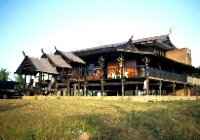 This was to be our last overnight stay of the journey. The Sisihorong Hotel was
really out in the sticks. Its situation on a small hilltop was great and the
wooden building was most attractive. However, when we realised that there was
no lighting, no baths and no hot water we were not so impressed. The following
day we were going to have to travel in airline seats next to civilised human
beings. What we really wanted was some place where we could have a really good
bath and then change into our cherished supply of clean clothes.
This was to be our last overnight stay of the journey. The Sisihorong Hotel was
really out in the sticks. Its situation on a small hilltop was great and the
wooden building was most attractive. However, when we realised that there was
no lighting, no baths and no hot water we were not so impressed. The following
day we were going to have to travel in airline seats next to civilised human
beings. What we really wanted was some place where we could have a really good
bath and then change into our cherished supply of clean clothes.
For the time being we were scheduled to go and visit a village where all visitors had to wear black clothes. This had always seemed a strange idea, but now we were due to see how it worked. We were duly dressed up in hired black clothes and we were bussed to a path where we set off to walk to the village. It was quite a long walk: normally something we would be pleased to have. However the clothes were too hot and sticky and the local people were clearly killing themselves with laughter at the sight of us. When at last we arrived at the intended village, we found that about 40% of the people were in black with the rest in red tee shirt and shorts or whatever they fancied. We were supposed to visit the headman in his house which was all black. That did not happen; we were told the headman was very ill and could not receive visitors. Very sensible of him! These visitors might just possibly have done him an injury! We turned and walked back. Those who could do so removed their black clothing.
After dinner there was some dissatisfaction expressed. A promise was made to try and arrange an early start and to negotiate a hotel lunch plus the use of showers. We then settled to a more amicable mood and sat around in the warm night air on the veranda chatting and listening to some locals playing music nearby.
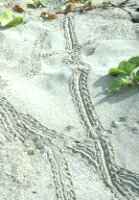 The last day started with a hurried drive along the coast road, stopping
briefly to look at small outrigger fishing boats coming home and to wonder at
the unidentifiable tracks across the beach to the sand dunes {giant
millipedes?}.
The last day started with a hurried drive along the coast road, stopping
briefly to look at small outrigger fishing boats coming home and to wonder at
the unidentifiable tracks across the beach to the sand dunes {giant
millipedes?}.
About lunchtime we arrived back at the now-familiar Delia Orchid Hotel. On the way a phone call had been made to arrange the use of rooms and showers. That was just what we needed. When we finally left clean, well-dressed and well-fed we were in a better mood to face our long journey back to the UK.
In all, this was an interesting trip which will produce pleasant memories for years to come. It is just a pity we couldn't have had a little more trekking. The trip was called the "Sulawesi Highlands Trek" and the forested area around Taba was superb walking. Why only one day of it?